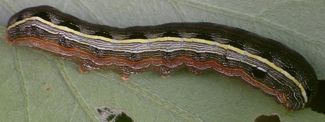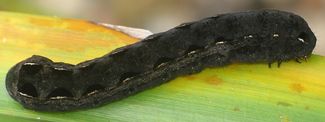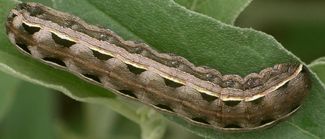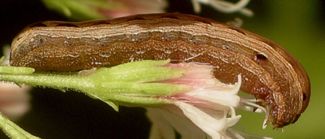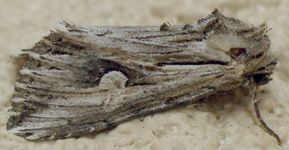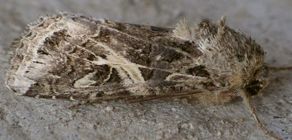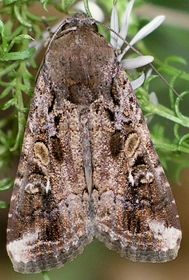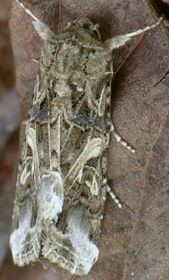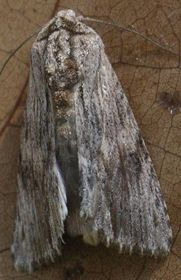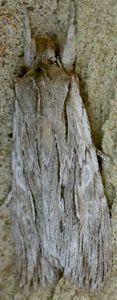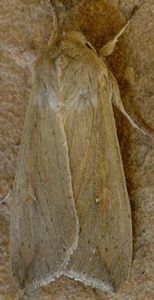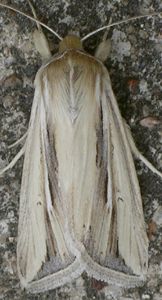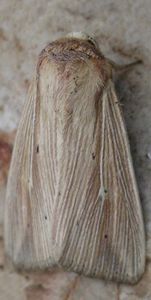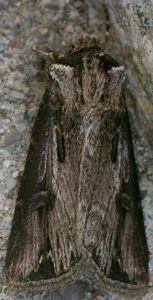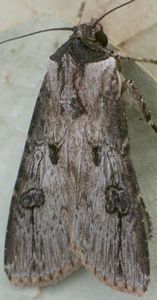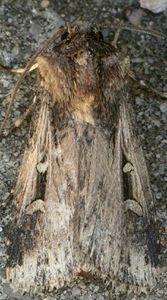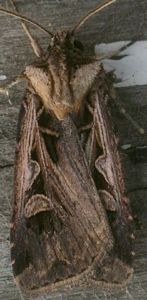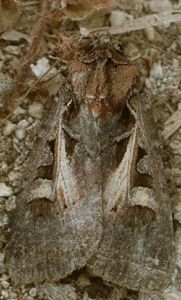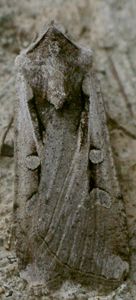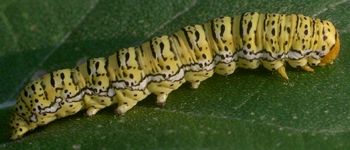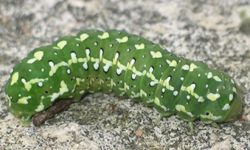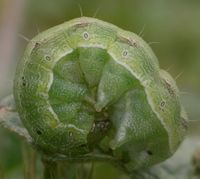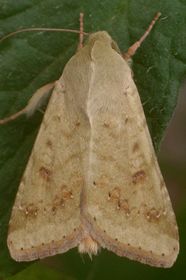
| Noctuidae ~ Owlet Moths |
page 1 ![]() page 2
page 2 ![]() page 3
page 3 ![]() page 4
page 4 ![]() page 5
page 5 ![]() page 6
page 6 ![]() page 7
page 7 ![]() page 8
page 8
|
There are several genera of noctuids whose larvae are commonly called "armyworms," as well as the similar cutworms (so named because some species actually cut off seedlings and drag them underground to eat). For many people, these are just plain "worms." The caterpillars tend to be sort of fat, hairless, and, well, wormy looking. Many of them are green or mottled brown colors and are not at all attractive. Armyworms are usually the bane of gardeners as they savor cultivated plants. I have a hard time identifying the different species, so they are definitely more common than my limited semi-certain IDs would suggest. There are many that I simply don't have the confidence to label.
One species is the Armyworm, Mythimna unipuncta. This larva is striped in brown, with a thin broken white line down its back and a light colored triangle on its face. I have found it under boards in farm areas. The Green Cutworm (Anicla infecta) is another striped caterpillar with very few surefire markings. The white stripe down the sides seems to be a good one. By far the most common of these that I find AND can identify is the Variegated Cutworm (Peridroma saucia). This saggy looking caterpillar is often found on low growing weeds. It has tiny white dots down its back and a black smudge on its humped butt.
There are several armyworms in the genus Spodoptera. The Fall Armyworm (Spodoptera frugiperda) feeds on grasses and low-growing plants. It's distinguishing characteristics are the wide dark lateral band with lighter brown above and below, black and white marks right behind the head, and black dots on the top of the butt. The Yellow-striped Armyworm is one of our most frequently seen caterpillars, although it doesn't always have its namesake yellow stripes. As you can see from the images below, it is variable. Very young caterpillars tend to be more striped than older ones. Note that the double line of dark arcs along the back are almost always discernable.
The Southern Armyworm (Spodoptera eridania), which I've seen only once, came as a caterpillar feeding on Pennywort (Hydrocotyle sp.) one fall. It's identity was unknown until it pupated and emerged as a 17 mm long adult in Dec. I think it resembles Melipotis jucunda or M. acontioides because of the longitudinal thin stripes on the wings.
Another similar looking gray moth with lines on its wings is the Gray Half-spot (Nedra ramosula). It's pretty obvious where the common name comes from. I have not found this species in the Austin area, but photographed it in Dallas. Its range includes our area.
Despite the very plain larvae, many moths of armyworms and cutworms are rather attractive and adult Spodoptera species are not too hard to tell apart. The Fall Armyworm Moth (Spodoptera frugiperda) is rather variable, with males having more white markings than females. It is about 17 mm long. The Yellow-striped Armyworm Moth (Spodoptera ornithogalli) has very angular and streaky markings and the wing veins are traced in white and it is a little bigger, at 20 mm in length. The Fall Armyworm Moth shows up, as you might expect, in the fall, while I've only found the Yellow-striped Armyworm Moth abundant one year in Feb. Considering how common the caterpillars are, I'm surprised I haven't seen more adults.
The Armyworm Moth (Mythimna unipuncta) is a plain but sleek tan insect that shows up regularly in the spring and fall. The small light dot in each wing (get it - unipuncta?) is a good ID mark. There is yet another sort of long and slender gray moth with streaks of black (compare to Melipotis and Cucullia). It is a Pinion (Lithophane lemmeri), about 20 mm long and I have found only one, in December. Its caterpillar is shown farther down this page. Notice that all the moths in this group are sort of long and narrow, and they are all at least medium-sized. Some are very sleek looking. I think the Wheathead Armyworm Moth (Faronta diffusa) is quite handsome and easy to recognize. About 18 mm long, it is moderately common in the spring and fall. The Adjutant Wainscot (Leucania adjuta) seems to show up at about any time of year. It is shorter than the others shown with it, at about 15 mm long, and at first looks rather plain. Upon close inspection, though, the myriad fine white lines are visible, along with a few black dots. This moth also has a very "hump-backed" appearance because of the thick hair on its thorax.
While the moths shown above are similar but rather easily distinguished, the next illustrations can be a nightmare for identification. They are all so easily mixed up that some have even been reshuffled among the different genera. The darts are characterized by their substantial hairy "shoulder pads" which make them look like they are wearing old-fashioned fur collared coats. They are frequently attracted to lights. The Rascal Dart (Feltia malefida) and the Subterranean Dart (Feltia subterranea) were previously in the genus Agrotis. The Venerable Dart (Agrotis venerabilis) remains there. As you can see, the intricate lines and spots are quite similar on all three of these species. Luckily, these don't seem to be too variable, so using such subjective aspects as darkness is a legitimate tool. Note, also, the various patterns on the hairy pronotums. All three of these species are about 18 to 20 mm long. The two Feltia species show up in the spring while Agrotis venerabilis appears in the fall.
The other two Feltia species I've included are not at all common. In fact, I've never seen the Tricose Dart (F. tricosa) in this area, although it is reported to be here. I took this photo in Wisconsin. There is another species, F. subgothica, which also occurs here and it looks almost identical to F. tricosa. Both of those look disturbingly similar to the Master's Dart (Feltia herilis), which I have seen only once, in October. I am only about 75% confident in these IDs.
Another single sighting, this time in Nov., accounts for Hemieuxoa rudens. This species is about the same size as the darts, and has a similar look although the markings are unique. The two relatively plain looking moths here are quite common. Anicla infecta, the Green Cutworm Moth, is about 18 mm long and commonly shows up in late winter and early spring, as well as summer. The dark brown area behind the head is always quite distinct. The Pearly Underwing (Peridroma saucia) is the adult of the Variegated Cutworm. You know a caterpillar is really a pest when it has a separate name from the adult! While the larva is one of the more easily identified "worms," the Pearly Underwing is so vaguely marked and often dark and/or worn that it can be a real challenge. It is rather large, at 23 mm in length, and is most common in the late fall and winter, but sometimes shows up in the spring too.
The Faithful Quaker (Himella fidelis) is a rather common caterpillar that is simply really hard to see. Its green camouflage does the job. It can be separated from numerous other green caterpillars by the trio of thin white stripes below the thick line on each side. I've yet to find an adult.
The Gold Moth (Basilodes chrysopis) caterpillar is a stunning autumn insect. It's color admirably matches that of its host blossoms, Cowpen Daisy (Verbesina encelioides). During years when the plants thrive (they are annuals), the larvae are very common in large stands of the flowers. This is another adult that I've not yet found. Another pretty caterpillar that I have seen only once is Lithophane lemmeri. It feeds on Juniper, where its beautiful pattern and colors are well camouflaged.
The Corn Earworm (Helicoverpa zea) feeds on a wide variety of plants besides corn. I've found it eating thistle and Buffalo Bur (Solanum rostratum). Any insect that can eat something as spiky as those has to be one tough critter! Of course, the Corn Earworm also goes for garden plants, like tomatoes, so it can be a nuisance. This caterpillar, another of those green "worms," seems to prefer burrowing into its host plant, at least as much as possible, and it is usually deep into a slimy green mess when found. If disturbed, it always curls up as shown in the accompanying photo. The caterpillars have more patience than I do and I've never waited long enough for one to straighten out for a proper photo. The adult H. zea is an elegant looking 20 mm long golden moth with subtle markings and green eyes. The hair on its pronotum forms a smooth ridge down its back. Both the caterpillar and the adult are moderately common. I usually find these moths in the summer, but occasionally they are among the late autumn fliers that feed during the day as nights get cold, with wings blurred in flight.
I've seen Orthosia annulimacula just once, in February. It is about 22 mm long and has very subtle brown markings. It is a difficult moth to ID, but the slightly orange rings on its wings help. A much more distinctive moth, the Bent-line Dart (Choephora fungorum) is also a little more common. This 20 mm long insect has dusky pinkish wings with very clear lines and spots; it flies in the fall. The wide triangular wings don't look anything like the long narrow shape of other darts so one has to wonder where the common name came from. |
page 1 ![]() page 2
page 2 ![]() page 3
page 3 ![]() page 4
page 4 ![]() page 5
page 5 ![]() page 6
page 6 ![]() page 7
page 7 ![]() page 8
page 8
![]()




